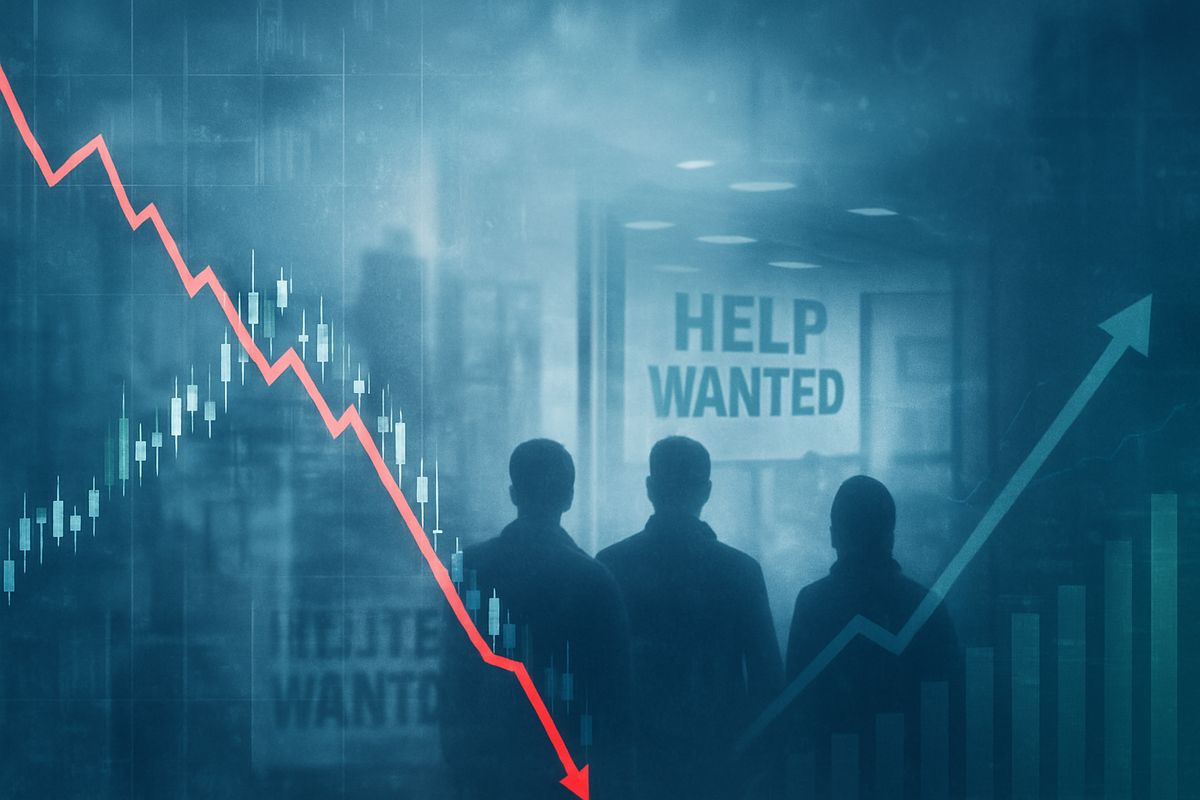
The financial markets are currently navigating a turbulent landscape, marked by a recent stock market slide, growing job market jitters, and a subsequent rally in Treasury bonds. This confluence of events signals a cooling labor market, prompting a discernible shift in investor sentiment away from riskier assets and towards perceived safe havens. High-valuation technology stocks and the volatile cryptocurrency market have borne the brunt of this shift, experiencing significant losses as investors recalibrate their expectations for future economic growth and corporate profitability.
This period of heightened caution, particularly in early November 2025, reflects a broader re-evaluation of asset valuations, especially within the Artificial Intelligence (AI) sector, which many analysts fear has entered bubble territory. The implications are far-reaching, potentially signaling future actions from the Federal Reserve and compelling businesses and investors alike to adapt to a more unpredictable economic climate.
Detailed Market Dynamics and Economic Catalysts
The global financial markets have experienced a complex series of shifts throughout 2025, culminating in the current volatility. A major market downturn occurred around April 2, 2025, triggered by the U.S. presidential administration's announcement of sweeping new tariff policies. This led to widespread panic selling, with the S&P 500 (NYSE: SPX) losing 10% of its value within two days, the Nasdaq Composite (NASDAQ: IXIC) tumbling 1,600 points, and the Dow Jones Industrial Average (NYSE: DJI) shedding over 4,000 points. Over $6.6 trillion was wiped out in what became the largest two-day loss in history. While a temporary pause in tariffs offered some relief and led to a strong rebound by June 2025, the underlying economic uncertainties persisted.
More recently, in late October and early November 2025, the market experienced another significant slide. On November 6, major U.S. averages were lower, with the S&P 500 (NYSE: SPX) down 0.7%, Nasdaq Composite (NASDAQ: IXIC) down 1.3%, and Dow Jones (NYSE: DJI) down 0.5%. This downturn was largely attributed to growing concerns over the valuation of AI stocks and weaker-than-expected job data. The tech-heavy Nasdaq and the S&P 500 (NYSE: SPX) saw their largest single-day percentage drops in nearly a month. Bank executives from institutions like Morgan Stanley (NYSE: MS), Goldman Sachs (NYSE: GS), and JP Morgan Chase (NYSE: JPM) have openly warned of a potential market correction.
A significant catalyst for this recent downturn has been the pronounced job market jitters. Data from Challenger, Gray & Christmas Inc. revealed a staggering 153,074 job cuts in October 2025, marking the highest October figure in over two decades and a 175% increase from October 2024. Year-to-date job cuts for 2025 have surpassed 1 million, the highest since the COVID-19 pandemic, with the technology sector leading these reductions. Additionally, Revelio Labs indicated a loss of 9,100 nonfarm jobs in October. This evidence of a softening labor market reinforced a "risk-off" sentiment among investors. The ongoing U.S. federal government shutdown has further complicated the economic picture by delaying the release of crucial official economic data, leaving investors "groping around in the dark."
In direct response to the bleak job market news and the broader market slide, Treasury bonds experienced a rally. The 10-year Treasury yield tumbled its most in a month, hovering around 4.07% in early November. This bond rally was fueled by increased investor bets that the Federal Reserve would be compelled to continue cutting interest rates to stimulate the economy. The Fed had already cut its benchmark interest rate twice in 2025 prior to November, with a 25 basis point reduction in late October bringing the federal funds rate to 3.75%-4.0%. A cooling labor market is often perceived as creating an "open door" for the Fed to ease monetary policy, which typically boosts bond prices and lowers yields.
Companies Navigating the Headwinds and Tailwinds
The current market environment presents a stark dichotomy for public companies, with high-valuation growth stocks facing significant pressure, while traditional safe-haven assets and defensive sectors show resilience.
High-Valuation Tech Stocks and Cryptocurrency Entities (Losing): Companies whose valuations are heavily predicated on future growth rather than immediate profitability are most vulnerable. The "AI bubble" concerns have placed intense scrutiny on the tech sector. Giants like Nvidia (NASDAQ: NVDA), Palantir Technologies (NYSE: PLTR), Advanced Micro Devices (NASDAQ: AMD), Tesla (NASDAQ: TSLA), Qualcomm (NASDAQ: QCOM), Fortinet (NASDAQ: FTNT), and even "Magnificent Seven" constituents like Amazon (NASDAQ: AMZN), Alphabet (NASDAQ: GOOGL), Meta Platforms (NASDAQ: META), and Microsoft (NASDAQ: MSFT) have experienced significant downturns. For instance, Palantir (NYSE: PLTR) was noted to be trading at 700 times earnings, raising questions about sustainable valuations. Even companies like Super Micro Computer (NASDAQ: SMCI), an AI-focused firm, saw declines after missing sales estimates.
The cooling labor market impacts these firms by signaling reduced consumer spending and business investment, directly affecting their revenue streams. Furthermore, the "risk-off" sentiment diverts capital away from speculative tech investments, causing a re-evaluation of "frothy" valuations. The cryptocurrency market, often considered a highly speculative asset class, also faced significant pressure. Bitcoin briefly dipped below $100,000 for the first time since June, and Ethereum (ETH-USD) also saw considerable losses, demonstrating crypto's correlation with the stock market as a risky asset during periods of market upheaval, wiping out over $1 trillion from the total crypto market capitalization since early October 2025.
Fixed-Income, Defensive Sectors, and Select Tech (Winning or Resilient): In contrast, the flight to safety has bolstered demand for government bonds. The U.S. Treasury market has rallied, with yields falling as investors seek stability. This benefits quality fixed-income investments, including bond funds, which offer income and potential performance during slowing economic activity and anticipated rate cuts.
Defensive sectors, such as Utilities and Consumer Staples, tend to be more resilient as demand for essential goods and services remains relatively stable even during economic slowdowns. Companies in these sectors, like those producing food, beverages, and household goods, often provide more predictable cash flows. Insurance companies can also benefit as rising interest rates (if they stabilize or rise from the recent rally's lows) improve returns on their bond investments.
Paradoxically, within the tech sector, certain cash-rich growth franchises and software companies with robust fundamentals and clear AI monetization strategies might show resilience. Companies like Meta (NASDAQ: META) and Alphabet (NASDAQ: GOOGL) have successfully issued bond deals, suggesting investor confidence in their long-term ability to monetize AI despite short-term stock volatility. Additionally, innovative financial products like tokenized T-Bill funds have seen growth as investors seek yield and transparency through blockchain technology in a "risk-off" environment.
Wider Significance and Historical Context
The current market dynamics are not isolated events but rather critical indicators of a broader economic recalibration, fitting into several significant industry trends.
AI Bubble Concerns and Market Concentration: The intense speculation and stretched valuations in the AI sector are a dominant theme. The Nasdaq Composite (NASDAQ: IXIC) has doubled since the launch of ChatGPT in November 2022, adding $18 trillion in market value, yet a Bank of America Global Fund Manager Survey in October 2025 found 54% of institutional investors believe AI stocks are in a bubble. Valuations for some AI-linked companies are considered "stretched," drawing frequent comparisons to the dot-com bubble of the late 1990s. This market concentration among a few "Magnificent Seven" companies raises systemic risks, as a correction in these few giants can significantly impact broader indices.
Shift in Monetary Policy Expectations: The market is reacting to a notable shift in monetary policy. The Federal Reserve has already cut the federal funds rate twice in 2025, with a 25 basis point reduction in late October. The cooling labor market is intensifying pressure on the Fed to consider further interest rate cuts. Goldman Sachs Research forecasts another rate cut in December 2025, followed by two more in March and June 2026. However, inflation, with core CPI at 3.2% in January 2025, remains above the Fed's 2% target, creating a delicate balancing act for policymakers.
Global Economic Slowdown and Trade Tensions: These market events coincide with growing concerns about a global economic slowdown. The OECD projects global growth to decelerate from 3.3% in 2024 to 2.9% in 2025 and 2.6% in 2026, with a significant slowdown expected in the U.S. (1.6% in 2025). Escalating trade tensions and tariffs, particularly between the U.S., China, and the European Union throughout 2025, are major contributors, disrupting supply chains and increasing costs. This combination of slowing growth and persistent inflation raises fears of "stagflation." Consumer confidence has plummeted to a 12-year low in March 2025, further signaling economic stress.
Ripple Effects and Policy Implications: The ripple effects are widespread. Businesses are likely to become more risk-averse, impacting corporate investment, M&A activity, and expansion plans. The intense scrutiny on AI valuations will pressure startups to demonstrate sustainable profitability. Supply chain disruptions, exacerbated by tariffs, will continue to challenge businesses. The Federal Reserve faces a complex task of stimulating economic activity through rate cuts while managing persistent inflation. Government fiscal policy, particularly tax cuts and increased spending, could further fuel inflation and economic volatility. Historically, policy-induced volatility, similar to the current trade war scenario, has been a recurring feature of economic cycles.
What Comes Next: Navigating Uncertainty
The path forward for the economy and financial markets is characterized by both challenges and potential opportunities, demanding strategic adaptation from companies and investors.
Short-Term (Late 2025 - Early 2026): The stock market is likely to remain volatile, with moderated gains. High valuations, especially in tech, will cap upside, while underlying economic resilience may provide some downside protection. The job market will continue to cool, with the unemployment rate potentially ticking up to 4.3%-4.8% by year-end 2025. Further Federal Reserve interest rate cuts are anticipated in response to the softening labor market, which will likely support a continued Treasury rally. Geopolitical risks and ongoing trade policy uncertainty will contribute to market choppiness.
Long-Term (2026 and Beyond): A more robust rebound and vigorous growth are projected for 2026, driven by an anticipated acceleration in corporate profits and a more favorable interest rate environment. The job market will be reshaped by AI and automation, creating new roles but also displacing existing ones. The Treasury market will be influenced by the Fed's easing cycle, leading to lower borrowing costs and stimulating demand.
Strategic Pivots for Companies: Companies must prioritize workforce transformation, investing in upskilling and reskilling to adapt to AI integration. Operational efficiency and cost management will be crucial in a moderating growth environment. Building resilient supply chains and embracing AI for innovation are key to maintaining competitiveness.
Adaptations for Investors: Investors need to adopt sophisticated risk-managed strategies, including diversification across asset classes. Favoring large-cap quality stocks, particularly those with strong AI monetization strategies, and increasing exposure to fixed income (e.g., 5-10 year bonds) are recommended. Periods of market volatility can create buying opportunities for fundamentally sound companies.
Emerging Opportunities and Challenges: Emerging markets face challenges from increased trade protectionism and global slowdowns but also offer opportunities due to resilient domestic demand and a growth premium over advanced economies. Countries like India, China (with policy support), Southeast Asia, and parts of Latin America and Africa present investment potential. The rapid digital transformation across these regions provides a strong foundation for business.
Potential Scenarios: The global economy is adjusting to new policy measures, leading to subdued growth. Scenarios include a "K-shaped" recovery, where AI beneficiaries thrive while others lag, or broader growth if lower rates and deregulation boost wider consumer spending. While a full recession is considered unlikely by many, the risk persists if consumption falters. Downside risks include escalating protectionism, financial market corrections, geopolitical escalation, and delayed rate cuts. Upside risks include resolution of trade tensions, rapid AI adoption, and more aggressive rate cuts by central banks.
Comprehensive Wrap-Up: Navigating a Shifting Landscape
The recent stock market slide, job market jitters, and Treasury rally underscore a period of profound re-evaluation and adjustment within the global financial system. The initial market shock in early 2025, largely a response to protectionist trade policies, has evolved into a more nuanced concern about asset valuations, particularly in the high-flying AI sector. The palpable softening of the job market, evidenced by significant layoffs and rising unemployment, signals a deceleration in economic activity, challenging the "soft landing" narrative that had previously buoyed investor sentiment. Concurrently, the Treasury rally indicates a clear flight to safety and aggressive bets on further monetary easing by the Federal Reserve.
Key Takeaways: The market is grappling with an "AI bubble" that echoes historical speculative frenzies, forcing a re-assessment of growth versus sustainable profitability. The labor market is unequivocally cooling, impacting consumer confidence and spending. This cooling, in turn, is pushing the Federal Reserve towards a more dovish stance, as reflected in the Treasury rally and recent rate cuts. Trade tensions and global economic slowdowns remain persistent headwinds, raising fears of "stagflation."
Market Moving Forward: The outlook is one of continued volatility and moderated growth. While some analysts project a rebound in corporate profits and overall market growth in 2026, the immediate future demands caution. High valuations in certain sectors will limit upside, while economic uncertainties could trigger further pullbacks. The interplay between inflation, interest rates, and employment data will dictate the market's trajectory.
Significance and Lasting Impact: These events signify a crucial recalibration in investor expectations, moving away from a "growth at all costs" mentality towards a greater emphasis on fundamentals, profitability, and risk management. The "Trump effect" on trade policies has demonstrated its potent capacity to induce market swings. The ongoing evolution of AI and its integration into the economy will redefine industries, but investors will demand clearer monetization pathways. Long-term, adaptability, diversification, and a keen eye on macroeconomic shifts will be paramount for sustained success.
What Investors Should Watch For: In the coming months, investors must remain vigilant.
- Federal Reserve Actions: The pace and timing of further interest rate cuts by the Fed will be the most critical factor. Any unexpected hawkish shifts could trigger significant market reactions.
- Economic Data: Despite the government shutdown, any available private sector data and subsequent official releases on inflation (CPI, PCE), GDP growth, and detailed employment figures (non-farm payrolls, wage growth) will provide essential insights into the economy's health.
- Corporate Earnings: Upcoming Q4 2025 earnings reports and forward guidance for 2026 will reveal how companies are navigating rising costs, supply chain issues, and the actual returns from AI investments versus market hype. Pay close attention to sectors showing resilience and those most vulnerable to economic slowdowns.
This content is intended for informational purposes only and is not financial advice




